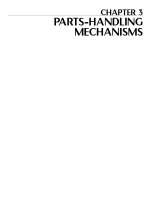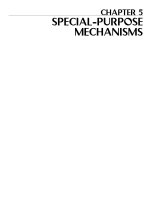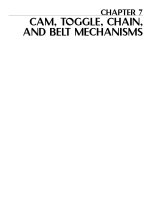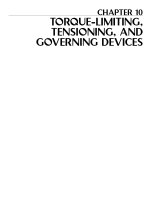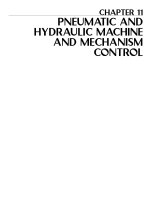Mechanisms and Mechanical Devices Sourcebook - Chapter 5
Bạn đang xem bản rút gọn của tài liệu. Xem và tải ngay bản đầy đủ của tài liệu tại đây (1.73 MB, 46 trang )
CHAPTER 5
SPECIAL-PURPOSE
MECHANISMS
Sclater Chapter 5 5/3/01 11:45 AM Page 127
128
NINE DIFFERENT BALL SLIDES FOR LINEAR MOTION
Fig. 1 V-grooves and flat surface make a simple horizontal ball slide
for reciprocating motion where no side forces are present and a
heavy slide is required to keep the balls in continuous contact. The
ball cage ensures the proper spacing of the balls and its contacting
surfaces are hardened and lapped.
Fig. 2 Double V grooves are necessary where the slide is in a verti-
cal position or when transverse loads are present. Screw adjustment
or spring force is required to minimize any looseness in the slide.
Metal-to-metal contact between the balls and grooves ensure accu-
rate motion.
Fig. 3 The ball cartridge has the advantage of unlimited travel
because the balls are free to recirculate. Cartridges are best suited
for vertical loads. (A) Where lateral restraint is also required, this type
is used with a side preload. (B) For flat surfaces the cartridge is eas-
ily adjusted.
Fig. 4 Commercial ball bearings can be used to
make a reciprocating slide. Adjustments are neces-
sary to prevent looseness of the slide. (A) Slide with
beveled ends, (B) Rectangular-shaped slide.
Sclater Chapter 5 5/3/01 11:45 AM Page 128
129
Fig. 5 This sleeve bearing, consisting of a hardened sleeve, balls,
and retainer, can be used for reciprocating as well as oscillating
motion. Travel is limited in a way similar to that of Fig. 6. This bearing
can withstand transverse loads in any direction.
Fig. 6 This ball reciprocating bearing is designed for rotating, recip-
rocating or oscillating motion. A formed-wire retainer holds the balls in
a helical path. The stroke is about equal to twice the difference
between the outer sleeve and the retainer length.
Fig. 7 This ball bushing has several recirculating
systems of balls that permit unlimited linear travel.
Very compact, this bushing requires only a bored
hole for installation. For maximum load capacity, a
hardened shaft should be used.
Fig. 8 Cylindrical shafts can be held by commercial ball bearings
that are assembled to make a guide. These bearings must be held
tightly against the shaft to prevent any looseness.
Fig. 9 Curvilinear motion in a plane is possible with this
device when the radius of curvature is large. However, uni-
form spacing between its grooves is important. Circular-
sectioned grooves decrease contact stresses.
Sclater Chapter 5 5/3/01 11:45 AM Page 129
130
BALL-BEARING SCREWS CONVERT ROTARY TO
LINEAR MOTION
This cartridge-operated rotary actuator quickly
retracts the webbing to separate a pilot forcibly
from his seat as the seat is ejected in emergen-
cies. It eliminates the tendency of both pilot and
seat to tumble together after ejection, preventing
the opening of the chute. Gas pressure from the
ejection device fires the cartridge in the actuator to
force the ball-bearing screw to move axially. The
linear motion of the screw is translated into the
rotary motion of a ball nut. This motion rapidly rolls
up the webbing (stretching it as shown) so that the
pilot is snapped out of his seat.
This time-delay switching device integrates a time func-
tion with a missile’s linear travel. Its purpose is to arm the
warhead safely. A strict “minimum G-time” system might
arm a slow missile too soon for the adequate protection of
friendly forces because a fast missile might arrive before
the warhead is fused. The weight of the nut plus the inertia
under acceleration will rotate the ball-bearing screw which
has a flywheel on its end. The screw pitch is selected so
that the revolutions of the flywheel represent the distance
the missile has traveled.
Fast, easy, and accurate control of fluid flow
through a valve is obtained by the rotary motion
of a screw in the stationary ball nut. The screw
produces linear movement of the gate. The swivel
joint eliminates rotary motion between the screw
and the gate.
Sclater Chapter 5 5/3/01 11:45 AM Page 130
three identical pinion gears at the corners
of an equilateral triangle. The central
gear is driven by a hand-cranked or
motor-driven drive gear similar to one of
the pinion gears.
Each pinion gear is mounted on a hol-
low shaft that turns on precise ball bear-
ings, and the hollow shaft contains a pre-
cise internal thread that mates with one
of the leadscrews. One end of each lead-
screw is attached to the movable plate.
The meshing of the pinions and the cen-
tral gear is set so that the three lead-
screws are aligned with each other and
the movable plate is parallel with the
fixed plate.
This work was done by Frank S.
Calco of Lewis Research Center.
131
THREE-POINT GEAR/LEADSCREW POSITIONING
The mechanism helps keep the driven plate
parallel to a stationary plate.
Lewis Research Center, Cleveland, Ohio
A triple-ganged-leadscrew positioning
mechanism drives a movable plate
toward or away from a fixed plate and
keeps the plates parallel to each other.
The mechanism was designed for use in
tuning a microwave resonant cavity. The
parallel plates are the end walls, and the
distance between is the critical dimen-
sion to be adjusted. Other potential appli-
cations for this or similar mechanisms
include adjustable bed plates and can-
tilever tail stocks in machine tools,
adjustable platforms for optical equip-
ment, and lifting platforms.
In the original tunable-microwave-
cavity application, the new mechanism
replaces a variety of prior mechanisms.
Some of those included single-point
drives that were subject to backlash (with
consequent slight tilting and uncertainty
in the distance between the plates). Other
prior mechanisms relied on spring load-
ing, differential multiple-point drives and
other devices to reduce backlash. In pro-
viding three-point drive along a track
between the movable and fixed plates,
the new mechanism ensures the distance
between, and parallelism of, the two
plates. It is based on the fundamental
geometric principle that three points
determine a plane.
The moving parts of the mechanism
are mounted on a fixed control bracket
that, in turn, is mounted on the same rigid
frame that holds the fixed plate and the
track along which the movable plate
travels (see figure). A large central gear
turns on precise ball bearings and drives
The Triple-Ganged-Leadscrew Mechanism, shown here greatly simplified, positions the movable
plate along the track while keeping the movable plate parallel to the fixed plate.
Sclater Chapter 5 5/3/01 11:45 AM Page 131
• Pick point B on PQ. For greatest
straight-line motion,
B should be at
or near the midpoint of
PQ.
• Lay off length
PD along FQ from F
to find point E.
• Draw
BE and its perpendicular bisec-
tor to find point
A.
• Pick any point
C. Lay off length PC
on FQ from F to find point G.
• Draw
CG and its perpendicular bisec-
tor to find
D. The basic mechanism is
ABCD with PQ as the extension of
BC.
Multilinked versions. A “gang”
arrangement (Fig. 8) can be useful for
stamping or punching five evenly spaced
holes at one time. Two basic linkages are
joined, and the
Q points will provide
short, powerful strokes.
An extended dual arrangement (Fig.
9) can support the traveling point at both
ends and can permit a long stroke with no
interference. A doubled-up parallel
arrangement (Fig. 10) provides a rigid
support and two pivot points to obtain
the straight-line motion of a horizontal
bar.
When the traveling point is allowed to
clear the pivot support (Fig. 11), the ulti-
mate path will curve upward to provide a
handy “kick” action. A short kick is
obtained by adding a stop (Fig. 12) to
reverse the direction of the frame links
while the long coupler continues its
stroke. Daniel suggested that this curved
path is useful in engaging or releasing an
object on a straight path.
132
UNIQUE LINKAGE PRODUCES PRECISE
STRAIGHT-LINE MOTION
A patented family of straight-line mechanisms promises to serve many
demands for movement without guideways and with low friction.
A mechanism for producing, without
guideways, straight-line motion very
close to true has been invented by James
A Daniel, Jr., Newton, N.J. A patent has
been granted, and the linkage was
applied to a camera to replace slides and
telescoping devices.
Linkages, with their minimal pivot
friction, serve many useful purposes in
machinery, replacing sliding and rolling
parts that need guideways or one type or
another.
James Watt, who developed the first
such mechanism in 1784, is said to have
been prouder of it than of his steam
engine. Other well-known linkage inven-
tors include Evans, Tchebicheff, Roberts,
and Scott-Russell.
Four-bar arrangement. Like other
mechanisms that aim at straight-line
motion, the Daniel design is based on the
common four-bar linkage. Usually it is
the selection of a certain point on the
center link—the “coupler,” which can
extend past its pivot points—and of the
location and proportions of the links that
is the key to a straight-line device.
According to Daniel, the deviation of
his mechanism from a straight line is “so
small it cannot easily be measured.” Also,
the linkage has the ability to support a
weight from the moving point of interest
with an equal balance as the point moves
along. “This gives the mechanism powers
of neutral equilibrium,” said Daniel.
Patented action. The basic version of
Daniel’s mechanism (Fig. 1) consists of
the four-bar
ABCD. The coupler link BC
is extended to P (the proportions of the
links must be selected according to a
rule). Rotation of link
CD about D (Fig.
2) causes
BA to rotate about A and point
P to follow approximately a straight line
as it moves to
P
1
. Another point, Q, will
move along a straight path to
Q
1
, also
without need for a guide. A weight hung
on
P would be in equilibrium.
“At first glance,” said Daniel, “the
Evans linkage [Fig. 4] may look similar
to mine, but link
CD, being offset from
the perpendicular at
A, prevents the path
of
P from being a straight line.”
Watt’s mechanism
EFGD (Fig. 5) is
another four-bar mechanism that will
produce a path of
C that is roughly a
straight line as
EF or GD is rotated.
Tchebicheff combined the Watt and
Evans mechanisms to create a linkage in
which point
C will move almost perpen-
dicularly to the path of
P.
Steps in layout. Either end of the cou-
pler can be redundant when only one
straight-line movement is required (Fig.
6). Relative lengths of the links and
placement of the pivots are critical,
although different proportions are easily
obtained for design purposes (Fig. 7).
One proportion, for example, allows the
path of
P to pass below the lower support
pivot, giving complete clearance to the
traveling member. Any Daniel mecha-
nism can be laid out as follows:
• Lay out any desired right triangle
PQF (Fig. 3). Best results are with
angle A approximately 75 to 80º.
Sclater Chapter 5 5/3/01 11:45 AM Page 132
133
Sclater Chapter 5 5/3/01 11:45 AM Page 133
134
TWELVE EXPANDING AND CONTRACTING DEVICES
Parallel bars, telescoping slides, and other devices
that can spark answers to many design problems.
Fig. 1
Figs. 1 and 2 Expanding grilles are often
put to work as a safety feature. A single par-
allelogram (fig. 1) requires slotted bars; a
double parallelogram (fig. 2) requires
none—but the middle grille-bar must be
held parallel by some other method.
Fig. 3 Variable motion can be produced with this arrangement.
In (A) position, the Y member is moving faster than the X member.
In (B), speeds of both members are instantaneously equal. If the
motion is continued in the same direction, the speed of X will
become greater.
Figs. 4, 5, and 6 Multibar barriers such as shutters and
gates (fig. 4) can take various forms. Slots (fig. 5) allow
for vertical adjustment. The space between bars can be
made adjustable (fig. 6) by connecting the vertical bars
with parallel links.
Fig. 7 Telescoping cylinders are the
basis for many expanding and contracting
mechanisms. In the arrangement shown,
nested tubes can be sealed and filled with a
highly temperature-responsive medium
such as a volatile liquid.
Fig. 2
Sclater Chapter 5 5/3/01 11:45 AM Page 134
135
Fig. 8 Nested slides can provide an
extension for a machine-tool table or other
structure where accurate construction is
necessary. In this design, adjustments to
obtain smooth sliding must be made first
before the table surface is leveled.
Fig. 9 Circular expanding mandrels are well-known. The example shown here is a less
common mandrel-type adjustment. A parallel member, adjusted by two tapered surfaces on the
screw, can exert a powerful force if the taper is small.
Fig. 10 This expanding basket is
opened when suspension chains are lifted.
Baskets take up little space when not in
use. A typical use for these baskets is for
conveyor systems. As tote baskets, they
also allow easy removal of their contents
because they collapse clear of the load.
Fig. 11 An expanding wheel has various
applications in addition to acting as a pulley
or other conventional wheel. Examples
include electrical contact on wheel surfaces
that allow many repetitive electrical func-
tions to be performed while the wheel turns.
Dynamic and static balancing is simplified
when an expanding wheel is attached to a
nonexpanding main wheel. As a pulley, an
expanding wheel can have a steel band
fastened to only one section and then
passed twice around the circumference to
allow for adjustment.
Fig. 12 A pipe stopper depends on a
building rubber “O” ring for its action—soft
rubber will allow greater conformity than
hard rubber. It will also conform more easily
to rough pipe surfaces. Hard rubber, how-
ever, withstands higher pressures. The
screw head is welded to the washer for a
leaktight joint.
Sclater Chapter 5 5/3/01 11:45 AM Page 135
136
FIVE LINKAGES FOR STRAIGHT-LINE MOTION
These linkages convert rotary to straight-line motion without
the need for guides.
Fig. 1 An Evans’ linkage has an oscillating drive-arm
that should have a maximum operating angle of about
40º. For a relatively short guideway, the reciprocating
output stroke is large. Output motion is on a true straight
line in true harmonic motion. If an exact straight-line
motion is not required, a link can replace the slide. The
longer this link, the closer the output motion approaches
that of a true straight line. If the link-length equals the
output stroke, deviation from straight-line motion is only
0.03% of the output stroke.
Fig. 2 A simplified Watt’s linkage generates an
approximate straight-line motion. If the two arms are of
equal length, the tracing point describes a symmetrical
figure 8 with an almost straight line throughout the
stroke length. The straightest and longest stroke
occurs when the connecting-link length is about two-
thirds of the stroke, and arm length is 1.5 times the
stroke length. Offset should equal half the connecting-
link length. If the arms are unequal, one branch of the
figure-8 curve is straighter than the other. It is straight-
est when a/b equals (arm 2)/(arm 1).
Sclater Chapter 5 5/3/01 11:45 AM Page 136
137
Fig. 3 Four-bar linkage produces an approximately
straight-line motion. This arrangement provides motion
for the stylus on self-registering measuring instruments.
A comparatively small drive displacement results in a
long, almost-straight line.
Fig. 4 A D-drive is the result when link-
age arms are arranged as shown here. The
output-link point describes a path that
resembles the letter
D, so there is a straight
part of its cycle. This motion is ideal for
quick engagement and disengagement
before and after a straight driving stroke.
Fig. 5 The “Peaucellier cell” was the first solution to the classical
problem of generating a straight line with a linkage. Within the physical
limits of the motion,
AC × AF remains constant. The curves described by
C and F are, therefore, inverse; if C describes a circle that goes through
A, then F will describe a circle of infinite radius—a straight line, perpen-
dicular to AB. The only requirements are that: AB = BC; AD = AE; and
CD, DF, FE, EC be equal. The linkage can be used to generate circular
arcs of large radius by locating
A outside the circular path of C.
Sclater Chapter 5 5/3/01 11:45 AM Page 137
138
LINKAGE RATIOS FOR STRAIGHT-LINE MECHANISMS
Fig. 1 (a), (b), (c), (d),
(e)—Isoceles linkages.
Fig. 3 The guide slot
is designed to
produce straight-line
motion.
Fig. 5 Watt’s linkage.
Fig. 4 (a), (b), (c), (d)—Pantograph linkages.
Fig. 2 Robert’s linkage.
Fig. 6 Tchebicheff combination linkage.
Fig. 7 Tchebicheff’s linkage.
Fig. 8 Walschaert
valve gear.
Sclater Chapter 5 5/3/01 11:45 AM Page 138
139
LINKAGES FOR OTHER MOTIONS
Fig. 2 A slight modification of the mecha-
nism in Fig. 1 will produce another type of
useful motion. If the planet gear has the
same diameter as that of the sun gear, the
arm will remain parallel to itself throughout
the complete cycle. All points on the arm
will thereby describe circles of radius R.
Here again, the position and diameter of the
idler gear have no geometrical importance.
This mechanism can be used, for example,
to cross-perforate a uniformly moving paper
web. The value for R is chosen so that 2πR,
or the circumference of the circle described
by the needle carrier, equals the desired
distance between successive lines of perfo-
rations. If the center distance R is made
adjustable, the spacing of perforated lines
can be varied as desired.
Fig. 3 To describe a “D” curve, begin at
the straight part of path G, and replace the
oval arc of C with a circular arc that will set
the length of link DC.
Fig. 4 This mechanism can act as a film-strip hook that will describe a nearly straight line. It
will engage and disengage the film perforation in a direction approximately normal to the film.
Slight changes in the shape of the guiding slot f permit the shape of the output curve and the
velocity diagram to be varied.
Fig. 1 No linkages or guides are included in
this modified hypocyclic drive which is rela-
tively small in relation to the length of its stroke.
The sun gear of pitch diameter D is stationary.
The drive shaft, which turns the T-shaped arm,
is concentric with this gear. The idler and
planet gears, with pitch diameters of D/2, rotate
freely on pivots in the arm extensions. The
pitch diameter of the idler has no geometrical
significance, although this gear does have an
important mechanical function. It reverses the
rotation of the planet gear, thus producing true
hypocyclic motion with ordinary spur gears
only. Such an arrangement occupies only
about half as much space as does an equiva-
lent mechanism containing an internal gear.
The center distance R is the sum of D/2, D/4,
and an arbitrary distance d, determined by spe-
cific applications. Points A and B on the driven
link, which is fixed to the planet, describe
straight-line paths through a stroke of 4R. All
points between A and B trace ellipses, while
the line AB envelopes an astroid.
Sclater Chapter 5 5/3/01 11:45 AM Page 139
140
FIVE CARDAN-GEAR MECHANISMS
These gearing arrangements convert rotary into
straight-line motion, without the need for slideways.
Fig. 1 Cardan gearing works on the principle that any
point on the periphery of a circle rolling on the inside of
another circle describes, in general, a hypocyloid. This
curve degenerates into a true straight line (diameter of
the larger circle) if the diameters of both circles are in the
ratio of 1:2. The rotation of the input shaft causes a small
gear to roll around the inside of the fixed gear. A pin
located on the pitch circle of the small gear describes a
straight line. Its linear displacement is proportional to the
theoretically true sine or cosine of the angel through
which the input shaft is rotated.
Fig. 2 Cardan gearing and a Scotch yoke in
combination provide an adjustable stroke. The
angular position of the outer gear is adjustable.
The adjusted stroke equals the projection of the
large diameter, along which the drive pin travels,
on the Scotch-yoke’s centerline. The yoke motion
is simple harmonic.
Sclater Chapter 5 5/3/01 11:45 AM Page 140
141
Fig. 3 A valve drive demonstrates how the Cardan
principle can be applied. A segment of the smaller circle
rocks back and forth on a circular segment whose
radius is twice as large. The input and output rods are
each attached to points on the small circle. Both these
points describe straight lines. The guide of the valve
rod prevents the rocking member from slipping.
Fig. 4 A simplified Cardan mechanism eliminates the
need for the relatively expensive internal gear. Here, only
spur gears are used, and the basic requirements must be
met, i.e., the 1:2 ratio and the proper direction of rotation.
The rotation requirement is met by introducing an idler
gear of appropriate size. This drive delivers a large stroke
for the comparative size of its gears.
Fig. 5 A rearrangement of gearing in the simplified
Cardan mechanism results in another useful motion. If
the fixed sun gear and planet pinion are in the ratio of
1:1, an arm fixed to the planet shaft will stay parallel to
itself during rotation, while any point on the arm
describes a circle of radius R. When arranged in conju-
gate pairs, the mechanism can punch holes on moving
webs of paper.
Sclater Chapter 5 5/3/01 11:45 AM Page 141
142
TEN WAYS TO CHANGE STRAIGHT-LINE DIRECTION
These arrangements of linkages, slides, friction drives,
and gears can be the basis for many ingenious devices.
LINKAGES
Fig. 1 Basic problem (θ is generally close to 90º). Fig. 2 Slotted lever.
Fig. 3 Spherical bearings. Fig. 4 Spring-loaded lever.
Fig. 5 Pivoted levers with alternative arrangements.
Sclater Chapter 5 5/3/01 11:45 AM Page 142
143
GUIDES
Fig. 6 Single connecting rod (left) is relocated
(right) to eliminate the need for extra guides.
FRICTION DRIVES
Fig. 7 Inclined bearing-guide. Fig. 8 A belt, steel band, or rope around the drum is fastened to the driving
and driven members; sprocket-wheels and chain can replace the drum and belt.
Fig. 9 Matching gear-segments.
Fig. 10 Racks and coupled pinions (can be substituted as friction surfaces for
a low-cost setup).
GEARS
Sclater Chapter 5 5/3/01 11:45 AM Page 143
144
NINE MORE WAYS TO CHANGE STRAIGHT-LINE
DIRECTION
These mechanisms, based on gears, cams, pistons, and solenoids, supplement ten
similar arrangements employing linkages, slides, friction drives, and gears.
Fig. 1 An axial screw with a rack-actuated gear (A) and an articulated driving rod (B)
are both irreversible movements, i.e., the driver must always drive.
Fig. 2 A rack-actuated gear with associated
bevel gears is reversible.
Fig. 3 An articulated rod on a crank-type
gear with a rack driver. Its action is restricted
to comparatively short movements.
Fig. 4 A cam and spring-loaded follower allows an input/output ratio to be varied according
to cam rise. The movement is usually irreversible.
Sclater Chapter 5 5/3/01 11:45 AM Page 144
